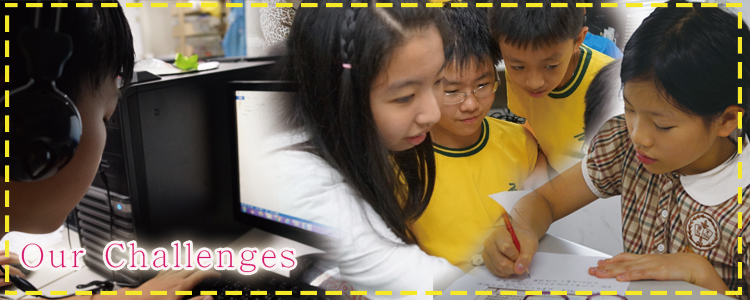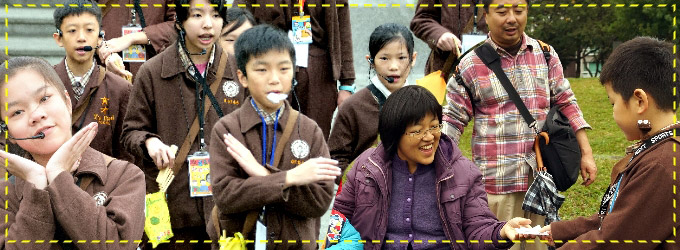|
Overview

The category we chose to participate in for the competition is " Local Music and Art " Forms.
Our community district is:
Yu-Tsai Elementary school is located in Yonghe District, New Taipei City, Taiwan. Aside from being a bustling commercial district, Yonghe is also filled with cultural and artistic breeze. Our topic, the Art of Shuochang, is also one of the special features of our school. There is often sound of bamboo clappers echoing on Yu-Tsai campus, and our students practice different forms of shuochang with varying accents, facial expressions, and hand gestures. This is what Yu-Tsai, from Taipei, Taiwan, is all about. We found happiness in the art of shuochang, and we discovered joy through different shuochang activities.

Project Outline

Shuochang is not only a form of art, but also a way to raise students’ linguistic proficiencies and confidence in Chinese. Through teamwork and group learning, we added fun into shuochang by incorporating lively body language and hand gestures. Ever since the inception of Yu-Tsai, we have been actively promoting education that would manifest students’ artistic temperament. We not only added ‘The Art of Shuochang’ to the curriculum of the middle-grade Yu-Tsai classes to promote this traditional art form, but also formed an after-school club so any student who is interested can sign up. It has also become one of our specialty clubs. The club has been representing school to perform abroad and gaining positive reviews every year since it began in 2013. This year’s Cyberfair team is going to team up with Yu-Tsai’s shuochang experts to experience and popularize the art of shuochang. Hopefully, we would be able to promote the art of shuochang into different communities or different parts of the world.

Our Internet Environment
School Internet Environment
Our Internet connection goes through the academic network. There are fifty computers in the computer room for our students to work on the project. There is between one to four computers in every office, including the library, and one computer in every classroom. All computers are connected to the web to facilitate searching, discussion and printing. Our outbound connection is a fiber-optic line that connects to the New Taipei City education network. Moreover, the entire school is covered by WiFi for staff access.
“The Original Artsy Shuochang Posse” Internet connection at home
ADSL, fiber-optic network, WiFi
“The Original Artsy Shuochang Posse” data transferring
We sometimes use memory sticks for storing files from school’s LAN to work from home. However, we use the Google Classroom for discussions and submitting files most of the time. As a result, we are able to work on the project from home or from school.

Challenges and Obstacles We Overcame

Time Allocation
Every one on the team came from a different class, so the time we have for studying shuochang and group practice was limited. In order to work on Cyberfair without missing out on regular school work, we rearranged our schedule to make time for the project, like meeting during recess or lunch hours. With the team working cohesively, we were able to complete the project without delays.
Understanding and Performing Shuochang
Before the Cyberfair project, there were eight of us who had no previous exposure to the art of shuochang. It was a brand new experience and challenge for us. We had to not only learn various forms of shuochang, but also memorize the scripts, articulate clearly, and incorporate movements and facial expressions into our performance. It was not easy at all, but none of us gave up. Luckily, we received encouragement from our teachers and classmates along the way, so our performance got better every day.
Interviews and Researches
In order to go more in-depth into our research, we conducted interviews with people who have been working with shuochang to share their personal stories. We also designed questionnaires to gather feedbacks and suggestions from the audience. Since the interviewees were mostly strangers to us, it presented a new challenge for us to overcome our inner fears and nervousness. We practiced numerous times to make sure the interviews would go smoothly. We even held mock interviews to prepare ourselves for any possible surprises. We aggressively approached people on the street in hope to complete the questionnaire. We got the job done with lots of courage and a smile on our face. It was with such determination that we were able to complete every interview and questionnaire and obtain valuable first-hand information.

Afterthoughts

Through our research on the Cyberfair project over the six-month period, we finally got a chance to understand the art of shuochang in depth. Shuochang is not merely cross talks and clappers, there are other performance types. We learned shuochang through different ways, and, more importantly, we felt the joy of shuochang with our hearts through watching and performing. After getting in touch with shuochang, we finally started to understand the uniqueness of shuochang. It can be performed by one, two, three, or more people in different ways.

We learned a lot about shuochang from our student shuochang expert teachers. We have also realized shuochang does require lots of practices and hard work, such as memorizing the script, paying attention to intonation, articulation, voice, facial expression, and movements. After learning more about the art of shuochang, we organized a series of learning, experiencing, and sharing events both in and out of school. Our level of confidence and sense of accomplishment got higher after each performance.
Cyberfair events are solidly packed with meaningful activities, and they are valuable experiences that we don’t usually get from ordinary textbooks!

|
